Categories
Archives
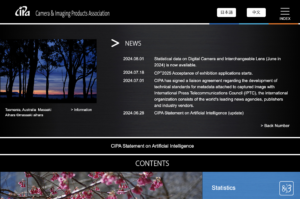
The IPTC has signed a liaison agreement with the Japanese camera-makers organisation and creators of the Exif metadata standard, CIPA.
CIPA members include all of the major camera manufacturers, including Nikon, Canon, Sony, Panasonic, FUJIFILM and more. Several software vendors who work with imaging are also members, including Adobe, Apple and Microsoft.
CIPA publishes guidelines and standards for camera manufacturers and imaging software developers. The most important of these from an IPTC point of view is the Exif standard for photographic metadata.
The IPTC and CIPA have had an informal relationship for many years, staying in touch regularly regarding developments in the world of image metadata. Given that the two organisations manage two of the most important standards for embedding metadata into image and video files, it’s important that we keep each other up to date.
Now the relationship has been formalised, meaning that the organisations can request to observe each other’s meetings, exchange members-only information when needed, and share information about forthcoming developments and industry requirements for new work in the field of media metadata and in related areas.
The news has also been announced by CIPA. According to the news post on CIPA’s website, “CIPA has signed a liaison agreement regarding the development of technical standards for metadata attached to captured image with International Press Telecommunications Council (IPTC), the international organization consists of the world’s leading news agencies, publishers and industry vendors.”
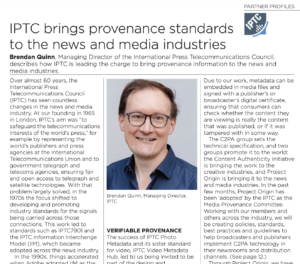
The IPTC’s Managing Director, Brendan Quinn, has written an article for the latest edition of the European Broadcasting Union’s technical magazine, EBU tech-i.
In the article, Brendan promotes the IPTC’s work in Media Provenance, including the founding of the IPTC Media Provenance Committee.
Brendan’s article can be found on page 17 of the PDF or print copy or the magazine.
The issue also contains a piece by Judy Parnall of the BBC, current Chair of the Committee, also covering C2PA and our joint work on media provenance.
The issue also contains interesting insights from European broadcasters on AI in media production, innovating to meet the challenges of covering the Paris 2024 Olympics, the creation of an Enterprise Architecture working group within the EBU membership, cybersecurity for media outlets, the future of broadcast radio in a world connected cars, and more.
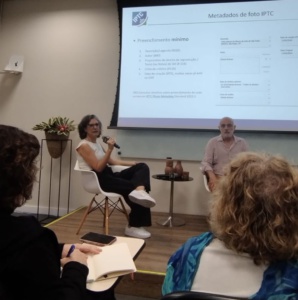
Media consultant and IPTC Individual Member Denise Durand Kremer gave a presentation on IPTC Photo Metadata at the Seminário Fototeca Brasileira – the Brazilian Photo Library Seminar.
Over three days, more than 80 people got together to discuss the idea of a national photo library for Brazil. Denise was invited by the Collection and Market group Acervo e Mercado to talk about her experience as an iconographic researcher and about the IPTC standard for photographic metadata.
Photographers, teachers, researchers, archivists and public managers from institutions such as the Museu da Imagem e do Som de São Paulo – MIS (Museum of Image and Sound of São Paulo), Funarte, Instituto Moreira Salles, Zumví and Arquivo Afro Fotográfico participated in the event.
The meeting ended with a commitment from the Executive Secretary of the Ministry of Culture, to set up a working group to take the idea forward.
The seminar was recorded and will be available on SescTV.
Update, 6 August 2024: The video has now been released publicly. You can view Denise’s section below (in Brazilian Portuguese):
Thanks very much Denise for spreading the word about IPTC standards in Brazil!
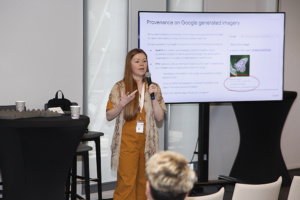
Last week CEPIC, the “centre of the picture industry”, held its annual Congress in Juan-les-Pins in France. This was the second time that the event was held at the Palais du Congres in Juan-les-Pins near Antibes, which is proving to be a great venue for the Congress with many repeat visitors who also attended last year.
IPTC was well represented at the event, with Managing Director Brendan Quinn presenting on two panels and many other IPTC members involved in presentations, panels or simply attending the event. IPTC members either presenting or in attendance included Google, Shutterstock, Getty Images, ANSA, IMATAG, PA Media / Alamy, TT, dpa, Adobe, Xinhua, Activo, APA, European Pressphoto Agency EPA and possibly more that we have missed!

One of the highlights for us was the Provenance and AI panel moderated by Anna Dickson, who until recently was with Google but is now with another IPTC member, Shutterstock. Presenters on this panel included Katharina Familia Almonte, product manager at Google, Andy Parsons, Director of the Content Authenticity Initiative (although Brendan ended up presenting his slides due to it being 4.30am for Andy in New York at the time!); Mathieu Desoubeaux, CEO of IPTC startup member IMATAG, and Brendan Quinn, Managing Director of IPTC.
Brendan used the opportunity to introduce the IPTC Media Provenance Committee and the work that the IPTC is doing on creating a C2PA Trust List for media organisations. Brendan put out a call for other media organisations who may be interested in joining the next cohort of certificate holders who will be able to obtain a certificate stored on the trust list and use it to cryptographically sign their media content. The discussion went on to look at the issues around using both C2PA and watermarking technology to protect image content.
Later in the day was the panel “Where Law and Technology Meet.” Moderated by Lars Modie (CEPIC, previously of IBL Bildbyrå / TT in Swededn) with speakers: Serguei Fomin (IQPlug, IPTC CEPIC representative), Brendan Quinn (IPTC), Franck Bardol (University of Geneva), Nancy Wolff (partner at the intellectual property, media and entertainment law firm of Cowan, DeBaets, Abrahams & Sheppard, LLP and DMLA counsel) and Katherine Briggs of Australian agency Envato which was recently acquired by Shutterstock.

At this panel, Brendan outlined IPTC’s recent guidance on metadata for generative AI images. This includes the Digital Source Type property but also guidance on using the Creator, Contributor, and Data Mining properties to signal ownership and rights licensing information associated with images, particularly for engines that “scrape” web content to train generative AI models.
Many stimulating conversations always make the CEPIC Congress a valuable event for us to attend, and we are already looking forward to next year’s instalment.

Google has added Digital Source Type support to Google Merchant Center, enabling images created by generative AI engines to be flagged as such in Google’s products such as Google search, maps, YouTube and Google Shopping.
In a new support post, Google reminds merchants who wish their products to be listed in Google search results and other products that they should not strip embedded metadata, particularly the Digital Source Type field which can be used to signal that content was created by generative AI.
We at the IPTC fully endorse this position. We have been saying for years that website publishers should not strip metadata from images. This should also include tools for maintaining online product inventories, such as Magento and WooCommerce. We welcome contact from developers who wish to learn more about how they can preserve metadata in their images.
Here’s the full text of Google’s recommendation:

Yesterday Nick Clegg, Meta’s President of Global Affairs, announced that Meta would be using IPTC embedded photo metadata to label AI-Generated Images on Facebook, Instagram and Threads.
Meta already uses the IPTC Photo Metadata Standard’s Digital Source Type property to label images generated by its platform. The image to the right was generated using Imagine with Meta AI, Meta’s image generation tool. Viewing the image’s metadata with the IPTC’s Photo Metadata Viewer tool shows that the Digital Source Type field is set to “trainedAlgorithmicMedia” as recommended in IPTC’s Guidance on metadata for AI-generated images.
Clegg said that “we do several things to make sure people know AI is involved, including putting visible markers that you can see on the images, and both invisible watermarks and metadata embedded within image files. Using both invisible watermarking and metadata in this way improves both the robustness of these invisible markers and helps other platforms identify them.”
This approach of both direct and indirect disclosure is in line with the Partnership on AI’s Best Practices on signalling the use of generative AI.
Also, Meta are building recognition of this metadata into their tools: “We’re building industry-leading tools that can identify invisible markers at scale – specifically, the “AI generated” information in the C2PA and IPTC technical standards – so we can label images from Google, OpenAI, Microsoft, Adobe, Midjourney, and Shutterstock as they implement their plans for adding metadata to images created by their tools.”
We have previously shared the news that Google, Microsoft, Adobe, Midjourney and Shutterstock will use IPTC metadata in their generated images, either directly in the IPTC Photo Metadata block or using the IPTC Digital Source Type vocabulary as part of a C2PA assertion. OpenAI has just announced that they have started using IPTC via C2PA metadata to signal the fact that images from DALL-E are generated by AI.
A call for platforms to stop stripping image metadata
We at the IPTC agree that this is a great step towards end-to-end support of indirect disclosure of AI-generated content.
As the Meta and OpenAI posts points out, it is possible to strip out both IPTC and C2PA metadata either intentionally or accidentally, so this is not a solution to all problems of content credibility.
Currently, one of the main ways metadata is stripped from images is when they are uploaded to Facebook or other social media platforms. So with this step, we hope that Meta’s platforms will stop stripping metadata from images when they are shared – not just the fields about generative AI, but also the fields regarding accessibility (alt text), copyright, creator’s rights and other information embedded in images by their creators.
Video next?
Meta’s post indicates that this type of metadata isn’t commonly used for video or audio files. We agree, but to be ahead of the curve, we have added Digital Source Type support to IPTC Video Metadata Hub so videos can be labelled in the same way.
We will be very happy to work with Meta and other platforms on making sure IPTC’s standards are implemented correctly in images, videos and other areas.

The IPTC is happy to announce that it will be working as an affiliate organisation of the TEMS project to build a Trusted European Media Data Space.
The product of a two-year-long tender and award process with the European Commission, TEMS is a joint undertaking of 43 organisations representing hundreds of stakeholders from 14 countries in the cultural and creative sectors, which aims to conceive and implement a common media data space across Europe.
The initiative is supported by the European Commission’s Digital Europe Programme (DIGITAL) and is a core element in the implementation of the European Data Strategy. With an investment of EUR 16.5 million, the consortium represents a milestone in the way the media sector will be able to share and extract value from data. By doing so, TEMS aims to support the economic development and future growth of local and regional media ecosystems across Europe.
Concretely, TEMS will lead the way for the large-scale deployment of cutting-edge services, infrastructures, and platforms. It will also address fighting misinformation, audience analysis, improving data flows in production chains, and supporting the adoption of AI and Virtual Reality technologies.
TEMS will evolve existing media platforms, embryonic data space infrastructures and provide open access to a common data space for any interested media stakeholder from any media sub-sector. This will help digital transformation and improve the competitiveness of the European media industry.
IPTC’s role is an advisory one. We will be working with TEMS partners on structuring data models and metadata formats, re-using and extending existing IPTC standards to create the framework the will power the data sharing for the media industry and beyond.
The TEMS partner organisations range from global news organisations to data platform providers, broadcasters, archives and media innovation units, as can be seen below.

To follow news from the TEMS project, see http://www.tems-dataspace.eu/ or follow @TEMS_EU on X/Twitter.
 On Tuesday 12 November 2023, a group of news, journalism and media organisations released what they call the “Paris Charter on AI and Journalism.” Created by 17 organisations brought together by Reporters sans frontières and chaired by journalist and Nobel Peace Prize laureate Maria Ressa, the Charter aims to give journalism organisations some guidelines that they can use to navigate the intersection of Artificial Intelligence systems and journalism.
On Tuesday 12 November 2023, a group of news, journalism and media organisations released what they call the “Paris Charter on AI and Journalism.” Created by 17 organisations brought together by Reporters sans frontières and chaired by journalist and Nobel Peace Prize laureate Maria Ressa, the Charter aims to give journalism organisations some guidelines that they can use to navigate the intersection of Artificial Intelligence systems and journalism.
The IPTC particularly welcomes the Charter because it aligns well with several of our ongoing initiatives and recent projects. IPTC technologies and standards give news organisations a way to implement the Charter simply and easily in their existing newsroom workflows.
In particular, we have some comments to offer on some principles:
Principle 3: AI SYSTEMS USED IN JOURNALISM UNDERGO PRIOR, INDEPENDENT EVALUATION
“The AI systems used by the media and journalists should undergo an independent, comprehensive, and thorough evaluation involving journalism support groups. This evaluation must robustly demonstrate adherence to the core values of journalistic ethics. These systems must respect privacy, intellectual property and data protection laws.”
We particularly agree that AI systems must respect intellectual property laws. To support this, we have recently released the Data Mining property in the IPTC Photo Metadata Standard which allows content owners to express any permissions or restrictions that they apply regarding the use of their content in Generative AI training or other data mining purposes. The Data Mining property is also supported in IPTC Video Metadata Hub.
Principle 5: MEDIA OUTLETS MAINTAIN TRANSPARENCY IN THEIR USE OF AI SYSTEMS.
“Any use of AI that has a significant impact on the production or distribution of journalistic content should be clearly disclosed and communicated to everyone receiving information alongside the relevant content. Media outlets should maintain a public record of the AI systems they use and have used, detailing their purposes, scopes, and conditions of use.”
To enable clear declaration of generated content, we have created extra terms in the Digital Source Type vocabulary to express content that was created or edited by AI. These values can be used in both IPTC Photo Metadata and IPTC Video Metadata Hub.
Principle 6: MEDIA OUTLETS ENSURE CONTENT ORIGIN AND TRACEABILITY.
“Media outlets should, whenever possible, use state-of-the-art tools that guarantee the authenticity and provenance of published content, providing reliable details about its origin and any subsequent changes it may have undergone. Any content not meeting these authenticity standards should be regarded as potentially misleading and should undergo thorough verification.”
Through IPTC’s work with Project Origin, C2PA and the Content Authenticity Initiative, we are pushing forward in making provenance and authenticity technology available and accessible to journalists and newsrooms around the world.
In conclusion, the Charter says: “In affirming these principles, we uphold the right to information, champion independent journalism, and commit to trustworthy news and media outlets in the era of AI.”
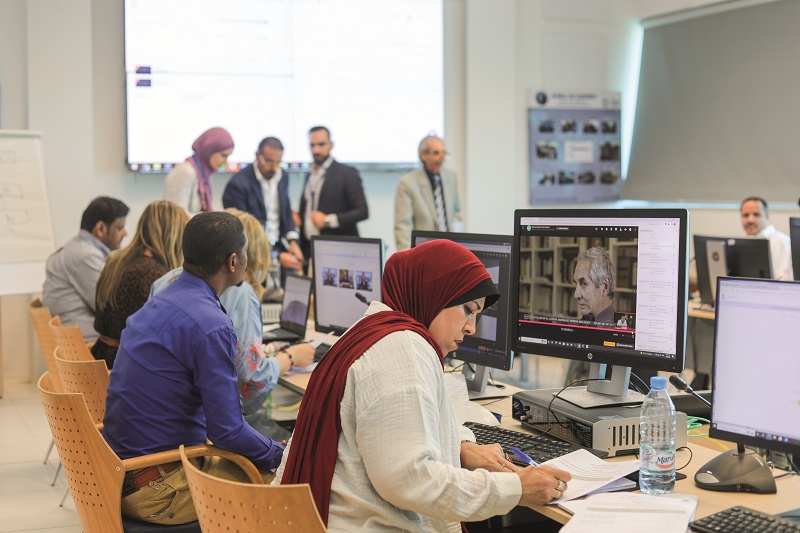
This weekend at the IBC broadcast industry event in Amsterdam, the Arab States Broadcasting Union (ASBU) will launch its news exchange network, ASBU Cloud, with IPTC’s NewsML-G2 standard at its core.
Developed for ASBU by IPTC member Broadcast Solutions, a systems integrator in the broadcast industry, ASBU Cloud uses NewsML-G2 to distribute content to partners.
After evaluating several metadata formats, ASBU chose to implement NewsML-G2 as a metadata schema and worked with IPTC to implement the standard. This ensures that ASBU content can be used easily by other international organisations like the European Broadcasting Union (EBU) and Asia-Pacific Broadcasting Union (ABU).
Broadcast Solutions System Architect Jean-Christophe Liechti explained the use of NewsML-G2 in an interview with Broadcast Pro magazine: “This XML-based standard for news exchange was developed and is maintained by the International Press Telecommunications Council (IPTC). It’s a successor to the original NewsML format and it provides a comprehensive and flexible framework for distributing any type of media, including text, images, audio and video. This metadata standard is language-agnostic. You can use standard dictionaries or manage your own to structure your data. We reached out to IPTC to ensure that our implementation closely met the standard. ASBU exchanges are now available as a NewsML-G2 feed like partner organisations like the EBU or major news organisations like Reuters, AP or AFP.”
The project is also based on Amazon Web Services, the Dalet Flex media asset management system, and uses innovative systems like the AI video metadata extraction engine Newsbridge (IPTC’s newest member).
The project will be launched at the IBC event in Amsterdam this Sunday, 17 September at 12.00. The launch will take place at the Broadcast Solutions outdoor booth 0.A01 located across from Hall 13 of the RAI exhibition centre.
Read more about ASBU Cloud at Broadcast Pro Middle East or contact IPTC if you’re interested in using NewsML-G2 in your own projects.
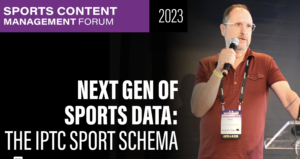
The video recording of IPTC’s presentation at the Sports Video Group Content Management Forum has now been released.
Paul Kelly, Lead of the IPTC Sports Content Working Group, gave a live presentation introducing the IPTC Sport Schema to participants at the event, held in New York City in July 2023.
Many of those participants have helped with the development and testing of the new model for sports data, including PGA Tour, NBA, NFL, NHL and more.
The full video is now available on SVG’s on-demand video platform, SVG Play.
In the presentation, Paul describes among other things:
- the motivation for the new model
- how it is different from IPTC’s existing sports standard SportsML
- how it can handle sports from tennis to athletics to football to golf and more
- how it might be used by broadcasters and sports data providers to attach sports data to video and other forms of media content
The Sports Content Working Group is now putting the final touches to the schema and its supporting documentation before it is put to the IPTC Standards Committee to be turned into an official IPTC standard.
Categories
Archives
- December 2025
- November 2025
- October 2025
- September 2025
- August 2025
- July 2025
- June 2025
- May 2025
- April 2025
- March 2025
- February 2025
- January 2025
- December 2024
- November 2024
- October 2024
- September 2024
- August 2024
- July 2024
- June 2024
- May 2024
- April 2024
- March 2024
- February 2024
- December 2023
- November 2023
- October 2023
- September 2023
- August 2023
- July 2023
- June 2023
- May 2023
- March 2023
- February 2023
- January 2023
- December 2022
- November 2022
- October 2022
- September 2022
- August 2022
- July 2022
- June 2022
- May 2022
- April 2022
- March 2022
- February 2022
- January 2022
- December 2021
- November 2021
- October 2021
- September 2021
- August 2021
- July 2021
- June 2021
- May 2021
- April 2021
- February 2021
- December 2020
- November 2020
- October 2020
- September 2020
- August 2020
- July 2020
- June 2020
- May 2020
- April 2020
- March 2020
- February 2020
- December 2019
- November 2019
- October 2019
- September 2019
- July 2019
- June 2019
- May 2019
- April 2019
- February 2019
- November 2018
- October 2018
- September 2018
- August 2018
- July 2018
- June 2018
- May 2018
- April 2018
- March 2018
- January 2018
- November 2017
- October 2017
- September 2017
- August 2017
- June 2017
- May 2017
- April 2017
- December 2016
- November 2016
- October 2016
- September 2016
- August 2016
- July 2016
- June 2016
- May 2016
- April 2016
- February 2016
- January 2016
- December 2015
- November 2015
- October 2015
- September 2015
- June 2015
- April 2015
- March 2015
- February 2015
- November 2014
![Preserving metadata tags for AI-generated images in Merchant Center
February 2024
If you’re using AI-generated images in Merchant Center, Google requires that you preserve any metadata tags which indicate that the image was created using generative AI in the original image file.
Don't remove embedded metadata tags such as trainedAlgorithmicMedia from such images. All AI-generated images must contain the IPTC DigitalSourceType trainedAlgorithmicMedia tag. Learn more about IPTC photo metadata.
These requirements apply to the following image attributes in Merchant Center Classic and Merchant Center Next:
Image link [image_link]
Additional image link [additional_image_link]
Lifestyle image link [lifestyle_image_link]
Learn more about product data specifications.](https://iptc.org/wp-content/uploads/2024/02/Screenshot-2024-02-20-at-09.56.52-1024x724.png)